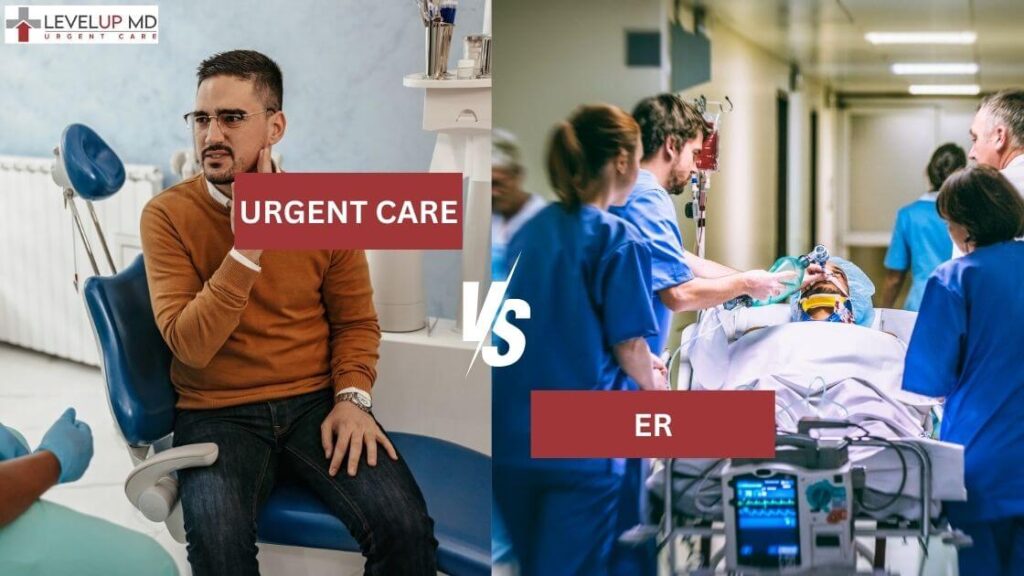
Urgent Care or ER? Know Where to Go for Your Medical Needs
Choosing between urgent care and the emergency room can be confusing. Knowing where to go when you need medical attention can save time, money, and stress. Let’s break it down so you can make the right call when it matters most.
What is Urgent Care?
Urgent care centres handle non-life-threatening medical issues that require prompt attention. They fill the gap between your primary care doctor and the ER. Urgent care is your best bet when you can’t wait for an appointment but don’t need emergency services.
“ There are currently over 14,000 Urgent Care centers in the U.S., and the current growth rate for new centers is seven percent.”
Types of Medical Conditions Treated

Urgent care handles a wide range of conditions, including:
- Minor injuries like sprains, cuts, and minor fractures
- Common illnesses such as flu, strep throat, and urinary tract infections
- Preventative services like vaccinations and health screenings
- Routine lab tests, including blood work, STD Testing, and X-rays
Benefits of Choosing Urgent Care
Urgent care centres offer several advantages, including:
- Shorter wait times compared to ERs
- Lower costs for non-emergency issues
- Walk-in availability without needing an appointment
- Extended hours, including evenings and weekends
How Urgent Care Differs from Primary Care
Unlike your primary care doctor, urgent care provides same-day treatment for sudden health concerns. They don’t replace regular check-ups or manage chronic conditions long-term, but they provide immediate solutions when your doctor isn’t available.
“As per the American Medical Association, around 70% of PCPs visits and around 40% of ED visits are unnecessary.”
What is an Emergency Room Or ER?
Emergency rooms handle severe, life-threatening conditions. ERs operate 24/7 and are equipped to treat critical health emergencies that require specialized care and hospital admission.
Critical Conditions That Require ER Visits

Visit the ER if you experience:
- Chest pain or difficulty breathing
- Severe injuries such as head trauma or deep wounds
- Signs of a stroke, such as sudden numbness or confusion
- Uncontrollable bleeding or severe burns
ER Facilities and Equipment Overview
Emergency rooms have specialized staff and advanced medical equipment, including:
- Imaging technology like CT scans and MRIs
- On-site laboratories for rapid diagnostics
- Intensive care units for life-threatening conditions
- Operating rooms for emergency surgeries
The Role of Emergency Medical Services (EMS)
EMS professionals provide life-saving interventions before you reach the hospital. Calling 911 can help determine the best course of action if you’re unsure whether to visit the ER.
Key Differences Between Urgent Care and ER
Severity of Conditions Treated
- Urgent Care: Treats minor to moderate conditions that require prompt attention.
- ER: Handles critical and life-threatening emergencies such as Cardiac arrest, Neurologic, Traumatic, Gastrointestinal, Infectious, Psychiatric etc that need immediate medical intervention.
Cost and Billing Differences
- Urgent Care: Lower costs, often under $200 for standard treatments.
- ER: Higher costs, ranging from $1,000 to $3,000 or more, depending on the services provided.
Accessibility and Location Convenience
“Over 78 percent of the U.S. population lives within a 10-minute drive of an Urgent Care center.” Source: UCA
Urgent care centres are usually located in neighbourhoods and shopping areas, while ERs are based within hospitals. Urgent care offers walk-in convenience, while ER visits often involve longer wait times.
Specialist Availability in ER vs. Urgent Care
ERs have specialists like cardiologists and surgeons available 24/7, whereas urgent care primarily provides general medical care and referrals if needed.
When to Choose Urgent Care vs. ER
“According to the UCA, in the U.S., the number of UCCs increased to 9,279 in 2019 from 8,774 in 2018. As per UCA, 400-500 new UCCs are opened in the U.S. every year.”
Signs and Symptoms That Need Urgent Care
Head to urgent care if you have:
- Cold or flu symptoms
- Minor injuries like cuts, sprains, or minor fractures
- Mild allergic reactions
- Fever without serious symptoms
Lab testing such as Blood, HIV, STD testing & Treatment
Red Flags That Require ER Treatment
Seek emergency care if you experience:
- Severe chest pain or difficulty breathing
- Loss of consciousness
- Seizures or sudden confusion
- Severe injuries or heavy bleeding
Decision-Making Tips for Parents and Workers
Urgent care may be the right choice if your child has a high fever but is still responsive. However, if they are lethargic or having trouble breathing, go to the ER. For workplace injuries, urgent care can handle most cases unless there’s severe trauma.

According to UCA’s 2022 Operations Benchmarking Report, 68.9 percent of Urgent Care centers offer traditional Urgent Care services, while 10.3 percent specialize in high acuity Urgent Care, 8 percent offer pediatric Urgent Care only, and 5.1 percent are a combination Urgent and primary care. Source: 2023-Urgent-Care-Industry-White-Paper (1).pdf
Case Studies: Real-Life Scenarios
A sprained ankle after a fall? Urgent care. Sudden sharp chest pain? ER. Making the right choice can prevent unnecessary ER visits and lower medical bills.
Common Misconceptions About Urgent Care and ER
“Urgent Care Can't Handle Serious Issues" Myth
“More than 50% of the visits to these facilities were COVID related in 2020”
Urgent care can handle more than just minor colds. They provide stitches, X-rays, and even IV fluids for dehydration.
"ER is Always the Best Choice" Myth
Not everything needs the ER. Many conditions can be treated faster and cheaper at urgent care.
Insurance Coverage Myths
Most insurance plans cover urgent care visits with lower copays than ER visits. Always check your insurance plan details before visiting.
Quality of Care Concerns
Urgent care clinics are staffed by experienced medical professionals, including doctors, nurse practitioners, and physician assistants.
Costs and Insurance Considerations
Cost Comparison: Urgent Care vs. ER
- Urgent Care Visits: $100-$200 for most services
- ER Visits: $1,000+ depending on severity and tests required
Hidden Fees to Watch Out For
- Ambulance transport
- Additional tests
- After-hours service fees
How to Save Money by Choosing the Right Care Option
- Consider telehealth options for minor concerns.
- Know the nearest urgent care locations.
- Review your insurance plan to understand your copays.
Convenience and Wait Times
Average Wait Times: Urgent Care vs. ER
- Urgent Care: 15-45 minutes
- ER: 2-4 hours, or longer for non-critical cases
Scheduling Appointments at Urgent Care Centers
Many urgent care centres offer online check-ins to reduce wait times. Walk-in options are also available for immediate care needs.
Emergency Rooms: When You Need Immediate Help
If you’re facing a life-threatening condition, don’t hesitate—head to the ER or call 911 immediately.
Preventative Care Options Available at Urgent Care
Urgent care offers vaccinations, screenings, and physical exams without a primary care appointment.
Follow-Up Care After an ER Visit
If you’ve visited the ER, follow up with your primary care provider or urgent care for ongoing monitoring and medication management.
When to Follow Up with Your Primary Care Doctor
If symptoms persist or you have a chronic condition, scheduling a primary care visit is essential for long-term health management.
Final Thoughts
Understanding the difference between urgent care and the emergency room helps you make the right decision when it matters most. For minor injuries and illnesses, urgent care offers fast, affordable treatment. In emergencies, always choose the ER. Knowing where to go can save you time, money, and stress.
Need immediate care in Bloomfield, NJ? Visit nearest urgent care center today.

